Boophilus is a genus of hard ticks found mainly in tropical and subtropical regions of Africa, America, Asia and Australia. 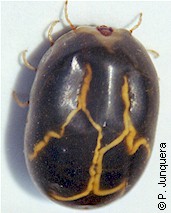 They are nowadays included in the genus Rhipicephalus.
They are nowadays included in the genus Rhipicephalus.
In this site, former Boophilus species are handled separately from the remaining Rhipicephalus species because their particular behavior is decisive for establishing control strategies, and because they are enormously important for the livestock industry in numerous tropical and subtropical regions of the world.
Boophilus ticks are one-host hard ticks. They affect mainly cattle, both European (Bos taurus) and Zebu cattle (Bos indicus), buffaloes, bisons and cervids (e.g. deer, antelopes, etc.). Occasionally they can also attach to horses and sheep, but usually they do not complete their life cycle on them. They do not affect humans, dogs, cats, pigs and birds.
The most important Boophilus species are:
- Boophilus microplus, the cattle tick, the southern cattle tick; occurs in Latin America, Australia, Southeast Asia and East Africa. It was eradicated from the USA in the first half of the last century. It has been recently introduced into West Africa. Australian Boophilus (Rhipicephalus) microplus ticks are now recognized to belong to R. australis, a sibling species of R. microplus.
- Boophilus annulatus, the American cattle tick; occurs in Mexico and parts of Africa. It was eradicated from the USA in the first half of the last century.
- Boophilus decoloratus, the tropical cattle tick, the blue tick; occurs in Central, East and Southern Africa.
Biology and life cycle of Boophilus ticks
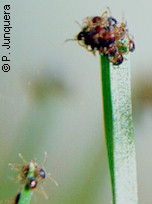
All Boophilus ticks are one-host ticks, i.e. only the engorged adult females drop off the host to lay eggs in the environment. Once the hatching larvae find a host, they will remain on it for the rest of their development to adult ticks. As all ticks they are obligate bloodsucking parasites, i.e. they cannot complete their life cycle without blood feeding.
Boophilus microplus is the most relevant Boophilus species for cattle. Unfed adults are rather small (3 to 5 mm) but engorged adult females can reach up to 1.2 cm length. Larvae are very small (<1 mm), usually not visible on infested animals.
Each female deposits up to 4'500 eggs in the environment. The eggs hatch 2 to 20 days later, depending on weather conditions. Temperature and high humidity accelerate egg hatching. Larvae do not migrate but remain where they hatched. Flooding and alternative hosts may transport them elsewhere.
Larvae climb onto grass and shrubs where they wait for a suitable host to pass by (questing). Hungry larvae can survive without feeding up to 4 months by dry and cool weather. Once they have found a suitable host they attach to it, and start feeding blood.
A single adult female may suck up to 0.5 ml blood. Development to adult ticks through the nymphal stage can be completed in about 2 weeks. Engorged adult females detach and drop off the host, lay their eggs on the ground and die.
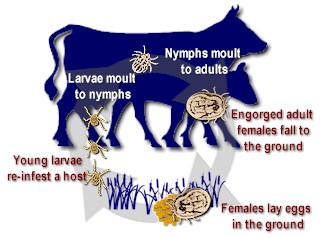
By suitable weather conditions (hot and humid) Boophilus microplus can produce up to 5 generations a year.
Life cycle and behavior of Boophilus decoloratus and Boophilus annulatus is similar to B. microplus.
All three species transmit Babesia (B. bovis, B. bigemina, B. divergens) a group of protozoan blood parasites responsible for bovine babesiosis (also called piroplasmosis, redwater, cattle fever, tick fever, Texas fever). High infestations may be fatal for cattle, especially for young animals if they were not protected through acquired immunity, either through previous exposure to infected ticks, or through vaccination.
B. microplus and B. decoloratus are also vectors of Anaplasma marginale, Anaplasma centrale (agents of bovine anaplasmosis) and Borrelia theileri (agent of spirochetosis), other blood parasites that can also be fatal for cattle.
Click here to learn more about the general biology of ticks.
Harm and economic loss due to Boophilus ticks on cattle
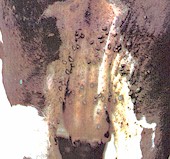
Boophilus ticks are certainly the most damaging cattle parasite in vast regions of Latin America, Australia and Africa. Each tick bite causes stress and weakens the host. It has been estimated that 20 to 30 ticks already have a negative impact on cattle (reduced weight gains, decreased milk production, higher susceptibility for diseases or other parasites, etc.). More specific calculations indicate that an infestation with 50 or more engorged Boophilus female ticks causes an annual weight reduction of 0.5 kg per tick. In dairy cows reduction of the annual milk production can go up to 200 liters per animal.
The economic impact of tick-borne diseases can be much more dramatic in case of a sudden outbreak of a tick-borne disease in a susceptible herd: it can cause dozens of deaths.
It must be mentioned that not only the engorged adult females (which a farmer "can see" on his cattle) cause harm and transmit tick-borne diseases, but also larvae and nymphs that a farmer "won't see" on his cattle because they are too small, and which are more numerous on a host than the engorged adult females. This is why often it is not a good strategy to treat a herd with a tickicide only when it carries "visible" ticks, but to treat the herds strategically targeting population control in the pastures rather than tick knockdown on the animals, even if they do not carry "visible" ticks.
Prevention and control of Boophilus ticks on cattle
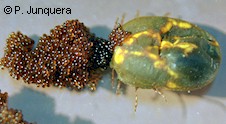
This is a complex topic. In spite of billions of USD spent on decades-long eradication campaigns in many countries and on R&D for new tickicides by universities and chemical companies, Boophilus ticks remain one of the most harmful pests of cattle in Latin America, Australia and parts of Africa.
It is quite easy to kill a few hundred cattle ticks on a few cattle. But it is a total different business to control a cattle tick population in a property: this remains a very tough, complex and often expensive business in many regions of the world.
Many factors play a role and substantially affect the number of available tools, the chances of success, the cost of control, the risk and the consequences of failure, etc.
- Climatic conditions (temperature, humidity, rainfall, etc.) and ecologic factors (type of vegetation, alternative hosts, etc.) determine whether a given habitat is more or less favorable for ticks, and they can be quite different for relatively close regions.
- Property and herd management (cattle breeds, pasture types and management, cattle density, farm purpose: dairy, breeding or fattening, etc.) influence the tick populations and the availability of tools for tick control.
- Other cattle parasites that have to be controlled as well, such as other tick species (e.g. Amblyomma or Rhipicephalus ticks), biting flies (e.g. horn flies and stable flies), bot flies, etc, limit the number of pesticides that can do the whole job, or may require using more than one product.
- Tick-borne diseases and the consequences of control measures on the enzootic stability of the herd (see specific chapter below).
- Tick resistance to tickicides, which is spreading and strengthening in an increasing number of regions can substantially limit the number of suitable parasiticides (see specific chapter below).
- National laws and regulations can forbid, restrict or impose certain products, application forms or treatment regimes, which can make sense from a global perspective, but may be inadequate for a particular property.
Non-chemical prevention and control of Boophilus ticks on cattle
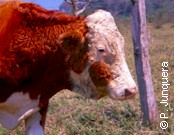
Cattle breeds resistant to ticks. The origin of many tick problems in tropical and subtropical regions is the introduction of pure European cattle breeds (Bos taurus) with a higher meat and milk performance than indigenous breeds or Zebu cattle (Bos indicus), but much more susceptible to ticks and tick-borne diseases, i.e. less resistant.
It has been calculated that survival of B. microplus larvae on Zebu cattle is about 15 times lower than on B. taurus cattle. This means that if you put one Hereford calf, one Zebu calf and one cross-bred calf in the same tick-infested paddock, if the Zebu calf becomes infested with 10 engorged adult female ticks, the cross bred calf will have 20 to 30 ticks, and the Hereford calf about 150 ticks. Whereas 10 ticks are usually below the economic damage threshold, 150 are far above this threshold.
Within the European breeds there are considerable differences regarding tick susceptibility. Some breeds (e.g. Angus, Holstein, Hereford) are more susceptible to ticks than others (e.g. Jersey). In addition, it is also known that individual animals within a herd often show significant differences regarding resistance to ticks. And it is also known, that all cattle are capable of developing certain natural immunity to ticks and tick-borne diseases when exposed to them. This is why calves are usually more susceptible then adult cattle.
In any case, an obvious and proven method to reduce cattle tick problems in tick endemic regions is to increase the amount of B. indicus "blood" in the herds. This has been done in certain regions. Unfortunately, in many other regions the opposite is more frequent. The reason is that producers are often urged to increase the productivity of their properties. Since they can neither reduce their costs, nor increase the cattle density of the farm, a rather cheap and easy option is to introduce more European "blood". It doesn't need significant investments or changes in the infrastructure and management of the property. Social and cultural factors also play a role: European breeds are often perceived as high-tech and prestige livestock.
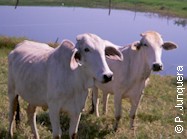
Pasture burning is a common practice in many regions of the world. Regarding cattle tick control, the experience is that it contributes to reduce tick numbers to some extent, but it is certainly not enough to eliminate or substantially reduce the tick populations.
Pasture plowing contributes to reduce potential hiding places for tick larvae below the vegetation and increases their exposure to direct sunlight, which shortens their survival off the hosts. But plowing is never enough to eliminate cattle tick populations, and not all properties are suitable for regular plowing the pastures.
Pasture rotation also helps reducing cattle tick populations if correctly done. It is based on the fact that in many cattle farms the only hosts where Boophilus ticks can complete their life cycle are cattle because adequate wildlife (e.g. deer, antelopes, etc.) is absent and other domestic livestock is unsuited for the ticks. Since tick larvae do not migrate and their survival on pasture is limited, they will starve to death if cattle are not allowed to graze there for a long enough period of time. By hot and humid weather larvae won't survive longer than 4 weeks. By dry and cold weather, larvae may survive up to 4 months on pasture. Each property has to determine what is feasible under its global management and production schedule.
Livestock alternation can be an alternative to pasture rotation in certain properties, e.g. between cattle and sheep, or cattle and horses. As previously explained cattle should be kept away between 1 and 4 months for larvae to starve, depending on the weather conditions. However, alternation may not be advisable for other reasons, e.g. management of gastrointestinal worms.
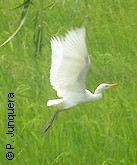
Biological control of Boophilus ticks using their natural enemies remains a research topic and has not yet delivered really effective and sustainable solutions for tick population control. Tick predators such as insects (e.g. ants, wasps), small rodents or birds (e.g. cattle egrets, guinea fowls, oxpeckers, etc.) do in fact consume significant amounts of ticks, but will not eliminate tick populations. One reason is that they are not specific tick predators, but feed on whatever is available.
The most promising results have been obtained so far with so-called entomopathogenic fungi, i.e. fungi that are pathogenic for ticks and other insects (e.g. Beauveria bassiana, Metarhizium anisopliae, etc.). In certain countries there are commercial products for crop protection based on such fungi, and there are reports that they can effectively control ticks on cattle too. However, a systematic commercial approach to cattle tick control using such fungi is still missing.
Several grass species from tropical and subtropical regions have been identified as potentially repellent or lethal for Boophilus and other tick species. The best-investigated ones belong to the leguminous genus Stylosanthes (S. humilis, S. hamata, S. scabra). As all leguminous plants they are usually welcome on pastures because they enrich the soil through their symbiotic nitrogen-fixing bacteria. However, field trials have shown that engorged female ticks that drop to the ground will move away from such grasses and deposit their eggs close to other grasses. Therefore, to effectively control ticks a very high density of Stylosanthes would be needed, but this would impair the general pasture quality for livestock.
Learn more about biological control of ticks and mites.
Vaccines against Boophilus ticks
There are true commercial vaccines against Boophilus microplus ticks in several countries. In fact this is the only real commercial vaccine against an arthropod parasite at all, and one of the very few vaccines against a metazoan (i.e. an animal with many cells) parasite. The Boophilus vaccine is based on a so-called hidden recombinant Bm86 antigen, a polypetide from the tick gut. Recombinant means that it is produced using bacterial cultures where the tick gene coding for Bm86 has been introduced through genetic engineering. It is called hidden, because the ticks do not introduce the antigen in the host's organisms during the blood meal and consequently the host itself does not produce antibodies against it.
But if the host is vaccinated with this antigen, it will indeed produce such antibodies, the ticks will get them during their blood meal, and their gut will be damaged. Most ticks will not survive such damage and will die on the host, others will still engorge and detach, but egg production and viability will be impaired. If all cattle in a paddock are vaccinated, the tick population in the paddock will be slowly but steadily decimated. After several years of disciplined vaccination the population will drop below the economic threshold level and can be even eliminated.
This Boophilus vaccine was introduced in the 1990's in Australia (TICKGARD, later abandoned) and in the meantime other similar brands have been launched (e.g. GAVAC, GO-TICK, TICK-VAC).
Tick vaccines are indicated for the control of tick populations, but will not protect single cattle from being infested by ticks, nor will they knock-down ticks that are already attached to cattle.
Tick vaccines have several key strengths:
- They are effective against Boophilus ticks resistant to tickicides, an increasing problem where these ticks are an endemic pest.
- They leave no chemical residues, i.e. they have a nil withholding period for meat or milk, and are particular attractive for dairy operations.
- They allow to reduce the amount of chemicals used in a property.
Unfortunately, tick vaccines also have weaknesses:
- Vaccination has to be regularly repeated every 6 to 10 weeks. The reason is that since the Bm86 antigen is hidden, blood-feeding ticks do not introduce it into the hosts, and the host's immune system produces antibodies only during several weeks after vaccination.
- Vaccination alone is mostly not enough to reduce the tick populations below the economic threshold level. This means that treatments with chemical acaricides must be continued, typically during 1 to 3 years, although with a decreasing frequency. Unfortunately, many farmers try the vaccine based on too optimistic expectations and are disappointed if they still see ticks on their cattle months after starting using it.
- Efficacy varies on each individual animal. The reason is that the efficacy of the vaccine depends on the performance of the immune system of the vaccinated animal. And this performance varies among healthy animals: some will produce a lot of antibodies very fast, other animals will produce less antibodies, or do it slower. And animals that are in poor condition (e.g. due to age, other diseases or infestations, stress, droughts, malnutrition, etc.) will also have a weaker immune system. This in contrast with classic chemical tickicides: they will kill ticks on cattle regardless of whether the cattle are healthy or not, young or old, etc.
- The tick vaccine does not control other cattle parasites (other tick species, biting flies, etc.). Their control will require using chemicals for months anyway and the use of the tick vaccine is than perceived as useless or redundant. There are reports that the Boophilus vaccine has also some efficacy against other tick species. But due to their different life cycle, the effect of the vaccine on their population will be usually irrelevant, or at least useless in most situations
Nevertheless, the Boophilus vaccine can be an excellent tool in dairy farms where Boophilus is the predominant tick species, but also on breeding or fattening cattle where Boophilus ticks can't be controlled anymore because the ticks have developed resistance to most tickicides.
Chemical prevention and control of Boophilus ticks with tickicides
Chemical tickicides for controlling Boophilus ticks are of three major types:
- Classic non-systemic ectoparasiticides that act by contact.
- Macrocyclic lactones with a systemic mode of action.
- Tick development inhibitors with a systemic mode of action.
All are for on-animal use. In most countries there are currently no acaricides approved for pasture treatment against cattle ticks. The major reason is that to effectively control the ticks on pasture the dose would be lethal for almost any invertebrate fauna in the pastures and for most of the vertebrates that feed on them (birds, reptiles, rodents, etc.). In addition, pastures would be also contaminated with chemicals, which could be toxic for livestock or leave illegal residues in meat and/or milk.
Classic contact acaricides
Classic contact acaricides used against cattle ticks (also called tickicides, ixodicides) are all veteran parasiticides of various chemical classes such as:
- Organophosphates (e.g. chlorfenvinphos, chlorpyrifos, coumaphos, diazinon, ethion, etc.)
- Amidines (mainly amitraz, also cymiazole)
- Synthetic pyrethroids (e.g. cypermethrin, deltamethrin, flumethrin, permethrin)
- Phenylpyrazoles (mainly fipronil)
Most of these products are also effective against other parasites as well (e.g. horn flies, stable flies, mites, lice, etc.), including other multi-host tick species (e.g. Amblyomma spp, Rhipicephalus spp). Amidines are a notable exception: they do not control parasitic flies. Mixtures are also quite frequent (e.g. organophosphate + synthetic pyrethroid, amidine + synthetic pyrethroid, etc.) to broaden the spectrum of activity or as an attempt to overcome resistance to one of the active ingredients.
Organochlorines were vastly used in the past, but are now prohibited for livestock in most countries. Neonicotinoids are not effective against ticks.
Classic acaricides are mostly available as concentrates for topical administration as dips and sprays, or as ready to use pour-ons. Most such products are approved for use on dairy cows: withholding periods depend on each product and national regulations.
As a thumb rule, dips are more effective than sprays and pour-ons, simply because sprays and pour-ons do not ensure a complete coverage of the whole body (e.g. ears, udders, perineum, below the tail etc.).
Insecticide-impregnated ear-tags, dusts and back rubbers are not suited for the control of cattle ticks.
Macrocyclic lactones
The macrocyclic lactones (also called endectocides) approved for use on cattle are abamectin, doramectin, eprinomectin, ivermectin and moxidectin. They are available mainly as injectables and/or pour-ons. Only eprinomectin was originally approved for use on dairy cows. Nowadays doramectin and moxidectin are also approved for use on dairy cows in some countries.
- Injectables with 1% active ingredient administered at the usual dose of 200 mcg/kg are usually not or only marginally effective against Boophilus ticks, certainly insufficient to control severe infestations. In some countries injectables with ≥3% active ingredient (mainly ivermectin or moxidectin) are approved for use on cattle at a dose of ≥630 mcg/kg. At this dose efficacy against Boophilus ticks is excellent, but the cost can be prohibitive, and the withholding period is usually ≥12 weeks.
- Pour-ons are often slightly better than the 1% injectables. However, for sustainable Boophilus control treatments should be repeated every 3-4 weeks during the tick season, which can become very expensive.
Macrocyclic lactones are also effective against other cattle parasites (e.g. gastrointestinal roundworms, mites, lice, myiases, etc.), but none is substantially effective enough to control other multi-host tick species (e.g. Amblyomma spp, Rhipicephalus spp). Mixtures of macrocyclic lactones with other parasiticides (e.g. benzimidazoles, levamisole) are also used, but such mixtures seldom improve the efficacy against cattle ticks.
Feed additives or drenches with macrocyclic lactones are not suited for the control of cattle ticks.
Tick development inhibitors
Fluazuron is currently the only tick development inhibitor in the market. It is available as a pour-on, either alone or in mixtures (e.g. with ivermectin). Fluazuron is highly specific for ticks, and has no efficacy against other cattle parasites, neither external (e.g. mites, lice or insects) nor whatever internal parasites. Fluazuron does not kill ticks directly, but inhibits molting during development. Affected eggs will not hatch, larvae will die during their molt to nymphs, and nymphs will die during their molt to adults.
Fluazuron is best suited for tick population control. For best results it must be used preventatively, i.e. the first treatment should be done at the beginning of the tick season, before cattle show adult ticks. If administered to heavily infested cattle it won't knock down those ticks: about 3 weeks will be needed for the animals to become tick-clean.
Fluazuron is not approved for use on dairy cows. However, it can be very useful for breeders, because a lot of fluazuron is passed from the mother cows to their calves through the milk. As a consequence the calves get enough fluazuron through their mothers' milk to be protected against ticks. Nevertheless, this requires treating the mother cows more frequently.
Fluazuron is also effective against several multi-host tick species (e.g. Amblyomma spp), but only as a preventative. A specific treatment scheme based on the local life cycle of such ticks has to be worked out for each property.
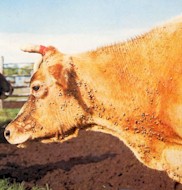
Efficacy of acaricides
The term "Efficacy" usually quantifies the capacity of a parasiticide to kill parasites as a percentage. A 95% efficacy means that 95 out of 100 parasites will be killed.
BUT most brands do not specify in their label which percentage efficacy they provide against a given parasite (they will if it is >99%, but probably won't if it is <90%). They are simply approved for its control.
NOW, approval is granted by regulatory authorities: EMEA in the EU, EPA and FDA in the USA, etc. And they decide what is the minimum efficacy that a parasiticide has to achieve to be approved for the control of a given parasite. This may be >99'9%, >99%, >95%, etc. For Boophilus control there are very strict countries (because they have eradication campaigns) such as Australia, Argentina or Uruguay, where approved products must achieve >99% control.
BUT there are dozens of countries in Latin America, Africa and Asia that will approve products if they provide only >80% control. This is not surprising, because anthelmintics are also approved in the EU and elsewhere if they show >80% efficacy. Coming back to the ticks. Depending on where you live, when you buy a tickicide you won't know whether it ensures >80% efficacy or >99% efficacy, i.e., whether it is a rather mediocre product, or it is an excellent product. Be aware that famous brands from multinational companies may have different qualities in different countries...
Residual effect and treatment intervals
Residual effect quantifies the time a product remains effective after treatment. Knowing the residual effect of a tickicide is essential to determine the best interval between treatments during the tick season in order to keep the herds protected.
When an active ingredient is administered to cattle, it acts upon the ticks (or whatever parasite) for a certain period of time. The residual effect may be 1 day for some products, and >3 months for other products; or 3 days against one parasite, and 10 days against another parasite, etc. The residual effect of a given product depends on many factors.
All non-systemic topical products (dips, sprays, pour-ons) remain for a certain time on the hair coat of the treated cattle and continue killing ticks. However, how much product remains active for how long depends on the type of chemical, on the initial concentration used, on its affinity for hair or skin lipids, on the speed it is degraded by sunlight (UV), on its water solubility (rain-fastness), on its volatility, etc. As a general rule, the residual effect of most topical products varies between 1 and 10 days.
For injectables with a systemic mode of action, the major elements that influence the residual effect are the dose administered and its fate in the organism of the treated animal: how fast it is distributed from the injection site to the rest of the body (strongly depending on the formulation!); whether it is stored (e.g. in the body fat) and slowly released to blood or not; whether it is vastly metabolized (i.e. decomposed) or not in the host's organism; if it is metabolized, how fast is metabolism and/or excretion, are the metabolites are also active against the parasite or not, etc., etc.
Systemic pour-ons show a combination of all these factors.
Assume a tickicide for dipping provides ≥99% tick killing efficacy after dipping, i.e. 99% of the ticks on cattle will be killed at dipping. Cattle go back to infested pastures and tick larvae will start re-infesting them. One day after dipping the product is still ~99% effective. This means that ~1% of the infesting larvae will not be killed and will attach. On day 2 after treatment efficacy will still be ~98%, i.e. ~2% of the re-infesting larvae will survive and attach. On day 3 after treatment efficacy may be ~96%, etc. on day 7 efficacy will drop below <90%. In a "severe country" this would mean one day residual effect, in a "relaxed country" this would mean 7 days residual effect...
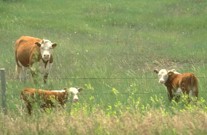
Assuming a product has 100% efficacy: after administration all Boophilus ticks have been killed, not only visible big ones (engorged adult females), but also small "invisible" ones (larvae and nymphs). Assuming the product has 7 days residual effect (i.e. 100% efficacy) once back on pasture first larvae will attach to it on day 7 after treatment. These larvae will need 21 days (on average) to complete engorgement and drop off the host to lay eggs. If you want to prevent these engorged ticks to drop and continue infesting the pastures, you should treat the cattle before they do it, i.e. 7+21=28 days after the last treatment. It the product had only 4 days residual effect, you should retreat the cattle after 4 + 21 = 25 days, etc. Some countries with eradication campaigns ignore the residual effect: dipping every 21 days is compulsory.
As a thumb rule, most classic dips provide between 1 and 7 days residual effect at >90%. Both efficacy and residual effect of topical sprays and pour-ons are usually lower. When using a 3,15% ivermectin injectable formulation it has been shown that to ensure >99.9% efficacy cattle should be treated every 31 days.
Fluazuron is a special case. After topical administration it is absorbed into blood through the skin and through licking (via intestinal absorption). Once in the blood it is deposited in the animals' fat from where it is slowly released back to blood. It is slowly excreted, almost unchanged. This allows blood levels that effectively interrupt the development of ticks for up to 10 weeks and beyond. However, because European breeds are naturally more susceptible to ticks, effective protection of European cattle may last for 8 to 10 weeks, whereas protection of Zebu cattle may last for up to 14 weeks. BUT since lactating cows excrete significant amounts of fluazuron through the milk, their protection will be shorter: 5 to 6 weeks for European breeds, 8 to 10 weeks for Zebu cows. The good news is that the calves won't need to be treated: they get their protection through the milk.
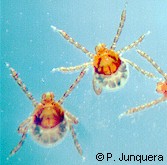
Treatment schemes
Depending on the criteria followed to determine the intervals between treatments several approaches can be distinguished:
- Eradication or suppressive
- Pragmatic or opportunist
- Strategic
- Economic threshold
Eradication or suppressive approach
The eradication or suppressive approach targets tick population elimination, i.e. eradication. It is based on the previously mentioned approach of re-treating all the cattle in a property every 3 weeks, based on the fact that, theoretically, this way no engorged female ticks are allowed to drop off the animals and lay eggs, i.e., the life-cycle is completely interrupted, because there are no alternative hosts for cattle ticks to survive on. After several years the ticks should be suppressed from the property. If all the properties do the same and no ticks are re-introduced through livestock transports, a whole region should become tick free.
This approach has been implemented in the last century in several countries in order to eradicate Boophilus ticks from whole countries or at least certain regions. It was successful in the USA. Elsewhere (e.g. Argentina, Australia, Uruguay) it was possible to free certain regions from ticks, but not the whole country. In any case, such eradication campaigns are complex and expensive, because they require a whole operational and bureaucratic organization to deal with controls of farms, borders and livestock transports, enforcing quarantine measures in case of re-infestation, imposing penalties, etc. Today it is believed that eradication worked only where the climatic conditions are sub-optimal for Boophilus ticks.
In any case, this approach puts tick populations under an enormous selective pressure and the risk of resistance development is considerable. However, resistance of Boophilus ticks to tickicides has developed more or less comparably in countries with or without eradication schemes.
As a general rule this approach is not recommended for individual properties. The reason is that if neighboring properties do not follow it as well, re-infestations are unavoidable: through flooding, wildlife, gaps in fences and enclosures, etc. And if herds of European cattle have lost immunity against blood parasites and are suddenly re-infested, it can have catastrophic consequences (see below).
Pragmatic or opportunist approach
This approach consists in treating the herds when they "carry many ticks". This is what most farmers do worldwide. It is based on the subjective feeling of the farmer regarding "many ticks", on his financial and management priorities, and on the wrong assumptions that treating livestock when it carries many ticks is the best way to hit the tick population. Such an approach will have an irrelevant impact on the tick population in the property. It is firefighting instead of fire prevention, and leaving a lot of embers around.
Strategic approach
This scheme consists in treating livestock when it most hits the tick population, i.e. at the beginning and at the end of the tick season in the concerned region. In most situations strategic approach is the most advisable. The reason is that treating early enough will decimate the first generation and thus prevent high tick populations to build up. And treating the last generation will reduce the number of over-wintering stages, which will diminish the number of ticks of the next season's first generation. This requires treating the herds early in the season when they are not perceived as carrying ticks, or only a few ones. Unfortunately many farmers are very reluctant to do this because they think it is superfluous to treat cattle that carry only a "few ticks": they are wrong!
Economic threshold approach
This scheme aims at "living together with the ticks" and acting only when they damage may become higher than the cost to treat them. This needs two major things:
- Knowing which is the highest number of ticks that livestock can support without severe economic losses. This depends on many factors, such as cattle breeds and farm purpose, prevalence and virulence of tick-born diseases in the tick population, etc.
- Determining a feasible method to monitor the herds for deciding whether the threshold has been reached or not.
This scheme makes a lot of sense in theory. The problem is often that point 1 is difficult to determine, and point 2 requires a lot of discipline.
Infestations with other two-host and three-host tick species
The previously explained schemes apply to regions where Boophilus ticks are the predominant species and other two-host or three-host tick species (e.g. Amblyomma spp, Rhipicephalus spp) are either not an issue, or only a minor one. This is the case for vast areas in Latin America and Australia. Where two-host and three-host ticks are endemic and they infect cattle, either alone or together with Boophilus ticks, their different life cycle has to be considered in order to determine the most advisable treatment schemes. This is the case for most of Africa south of the Equator and for tropical regions in Latin America.
| If available, follow more specific national or regional recommendations or regulations for tick control. |
Tick control and tick-borne diseases

Zebu cattle (B. indicus) and many American and African cattle breeds are naturally immune to both the ticks and babesiosis (tick fever). European breeds are not. They can acquire certain immunity if exposed to them or if vaccinated against Babesia. Crossbred cattle are somewhere in between.
The problem is that vaccines against Babesia usually contain attenuated strains of the parasites (B. bovis, B. bigemina) that are not completely safe, and are not available everywhere.
In properties with European breeds where cattle ticks have been successfully controlled for various years, cattle have probably lost whatever acquired immunity against tick fever. If such properties are in tick endemic regions, i.e., in regions where neighboring properties do have cattle ticks as well, they are at risk of becoming re-infested (flooding, gaps in fencing, etc.). If such unprotected cattle are suddenly infested with cattle ticks and consequently exposed to blood parasites, harm can be enormous, especially for young animals, with numerous fatalities.
Unfortunately, it is difficult to predict what may happen in a particular property. The reason is that not all ticks within a population are infested with blood parasites, or with the same amount of blood parasites. Maybe only 5% of the ticks are infested, maybe 20%. The higher the percentage, the more likely they will infect cattle. In addition, the blood parasite prevailing in a tick population may be more ore less virulent, i.e. after infecting an animal it may be more or less damaging. In some cases a few ticks may transmit enough parasites of a highly virulent strain to kill an animal. In other cases cattle may withstand hundreds of ticks without getting sick.
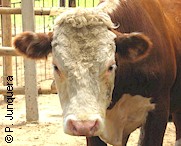
A problem with such sudden tick-re-infestations is that they are often discovered "too late". The reason is that tick-free cattle that catch a few hundred tick larvae on pasture will show visible ticks (i.e. early engorged female ticks) only about 2 weeks after infestation. This means that between infestation and its discovery, tick larvae, nymphs and young adults have been sucking blood and therefore transmitting blood parasites during about two weeks, long enough to transmit the disease and for cattle to become sick.
When choosing a treatment scheme among those previously mentioned, it is essential to estimate the risk for potential problems with tick-borne diseases. In many tropical and subtropical regions where cattle ticks are endemic, it is highly recommended to aim at reaching so-called enzootic stability, i.e. learning to live together with the ticks and the blood parasites. There will always be some harm to livestock, but sudden acute outbreaks will be vastly prevented. However, stability is not easy to maintain. An unexpected drought that weakens the herds makes them more susceptible to tick fever. Or tick numbers may unexpectedly increase due to resistance to tickicides or weather conditions, etc.
As previously mentioned, the best way to reduce the risks related to tick-borne diseases in endemic regions is to favor cattle breeds with natural immunity against ticks and tick-borne diseases.
Resistance of Boophilus cattle ticks to tickicides
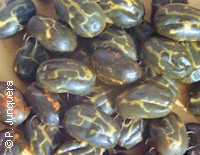
Resistance of Boophilus microplus to tickicides is widespread in Latin America and Australia, as well as resistance of Boophilus decoloratus in Africa.
It means mainly resistance to active ingredients belonging to the organochlorines, organophosphates, synthetic pyrethroids and/or amidines.
Prevalence and distribution of resistant tick populations are very irregular. Whereas one property may have serious resistance problems e.g. to synthetic pyrethroids, a neighboring property may not, or perhaps to organophosphates or amidines, etc. Due to the low mobility of tick larvae, the situation on each property depends strongly on its history of tickicide use in the last years.
As a general rule, resistance to synthetic pyrethroids is often very high (resistance factor of up to 1000 and beyond), which makes whatever product with a synthetic pyrethroid completely useless, even undiluted. Resistance to organophosphates ad amidines is usually not that high, with factors often <100. Such products may still provide some control but not complete and with no residual effect. The typical farm experience is that the product worked much better years ago.
Resistance has already been reported to fipronil (e.g. in Argentinina, Uruguay, Brasil, México) and to ivermectin (e.g. in Brasil, México, India, Uruguay). So far it is not yet a widespread problem and the resistance factors recorded are <100. But it is only a matter of time for the problem to worsen, since the use of these compounds on cattle is strongly increasing after generics have become available and the veteran tickicides are progressively abandoned.
The first cases of resistance of Boophilus ticks to fluazuron have been reported in Australia (2010) and Brazil (2014).
The number of multi-resistant populations is also increasing, i.e. simultaneously resistant to two or more chemical classes with different modes of action. An investigation in Mexico described a Boophilus microplus field population simultaneously resistant to organophosphates, amidines, synthetic pyrethroids and ivermectin. Another investigation in Brazil reported a strain resistant to organophosphates, amidines, synthetic pyrethroids and ivermectin and fluazuron, all active ingredients available for their control.
Learn more about parasite resistance and how it develops.